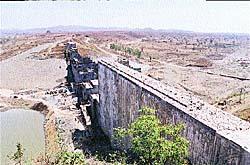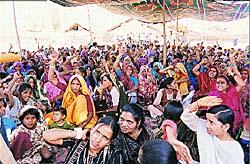Hell and high water
Frontline | Volume 19 - Issue 12, June 8-21, 2002 |  www.frontlineonnet.com
www.frontlineonnet.com
Close to a thousand people in 17 villages in Dhar district of Madhya Pradesh face an uncertain future as submergence under the Maan dam project looms ahead of them but the needed rehabilitation and resettlement measures remain a distant dream.
LYLA BAVADAM
UNJUST, unnecessary, unreasonable - these are some of the words that have been used by those who oppose the series of dams under execution in the Narmada valley. Now, a new word - harsh - can be added to the lexicon with reference to the actions of the Government of Madhya Pradesh in and around the Maan dam site. Situated on the river Maan, a tributary of the Narmada, in Dhar district of Madhya Pradesh, the dam is part of the gigantic Narmada Valley Development Projects.
 The 53 metre-high Maan dam is one of the largest of the ongoing Narmada valley projects.
The 53 metre-high Maan dam is one of the largest of the ongoing Narmada valley projects.
The 53m-high dam, which has been 17 years in the making, is due to be completed during this monsoon season when it will leave 17 villages in Dhar district submerged. Rehabilitation and Resettlement (R&R) measures for some 993 affected people are nowhere near completion, but work on the dam continues.
In May, the hottest month of the year in this central Indian State, the local administration cut off electricity supply, dismantled hand-pumps and sealed and bulldozed tubewells in all the 17 villages. The work crew also knocked down schools and other buildings, sending a clear message that the government was determined to complete the dam this year regardless of the status of the R&R measures. Prior to the 2001 monsoon the government had tried similar strong arm tactics but failed. In fact, when water levels in the villages began to rise, the government was forced to blast the river sluice on the Maan dam to prevent village residents from drowning.
However, this year the government seems determined to press ahead. The affected people are protesting against the government's harsh actions by staging a dharna in the State capital of Bhopal. Even basic amenities such as drinking water are now at a premium in the affected villages. Jagdishbhai, a dam-affected person who is participating in the dharna in Bhopal said, "We depend on wells that haven't dried out. We are running here and there searching for water. There are some tanker facilities but they are erratic and inadequate."
Sanjay Dubey, Dhar District Collector, said, "We have ensured that drinking water is available from open wells dug by the government and also supply through water tanks. In addition, since none of the villages are coming under full submergence, the oustees are free to access government facilities which are outside the submergence area. In fact, in the last few days we have bored some 10 tubewells in this area for people who have got their houses made outside the submergence area."
However, in this case it is not the remedial action that the government has taken, but the drastic action that led to the creation of a drought-like situation that is relevant. Collector Dubey explains the rationale behind the government's actions. "There will be submergence this monsoon. Most of the people have left but there are a few hard cases and if need be we will use force to get them out of the zone." Dubey explains that it has been the government's policy to withdraw its resources prior to submergence. "It is in this background that we have removed government facilities," he said.
 Residents of Khedi Balwadi, one of the 17 dam-affected villages in Dhar, at a public hearing - a file photograph.
Residents of Khedi Balwadi, one of the 17 dam-affected villages in Dhar, at a public hearing - a file photograph.
AS has become common in the case of the Narmada valley dams, the main issue is being glossed over here. The Maan project is about 17 years old. Yet drastic and undemocratic actions are being taken just one month before submergence. If, as the Collector claims, "the government was committed to the rehabilitation of the oustees... and had channelled resources meant for the rehabilitation process to provide infrastructural facilities at the sites," why is R&R still incomplete? More than 600 people attended the Indian People's Tribunal (IPT) on Environment and Human Rights public hearing to air their grievances on the issue.
The dam had received environmental clearance as far back as 1994. But the clearance was a conditional one in which successful R&R was the criteria for allowing construction. Some other conditions relating to afforrestation and soil conservation have also not been followed. According to the Narmada Bachao Andolan (NBA), the government has been slack on the issue of R&R because the majority of the affected people are Adivasis, who constitute a vulnerable group with no real voice. A report on the Maan project by the IPT stated: "Clearly, Adivasis are not seen as an essential part of the body politic or the nation state which is being developed. They are seen to have no right to define their own development."
One of the preconditions for the grant of environmental clearance was that the affected Adivasis and others be resettled and compensated with non-forest agricultural land - a condition that is reflected in Madhya Pradesh's rehabilitation policy, 1998 as well as in the Narmada Water Disputes Tribunal Award. In 1984, the Narmada Control Authority had said "...for tribals, there is no rehabilitation more effective than providing land as the source of livelihood." But it was only in 1999 that the State government set up a Rehabilitation Planning Committee for people affected by the Maan project. In its order constituting the formation of the committee, the State government specified that R&R measures in respect of "families living in the areas likely to be submerged should be completed at least six months prior to submergence." While the submergence is likely in June, R&R is still incomplete. Last December, a gazette notification said that 865 families would be affected by the project this monsoon. Of these, so far only 22 families have received land.
The idea behind offering alternative land to the affected people was to ensure that they were provided means of livelihood on a continuous basis and to see that the disruption caused by R&R was minimised. Instead, in violation of the established R&R policy, the State is now offering cash compensation. Another government notification says that cash compensation should be given only if the affected person himself applies for it. If the applicant was an Adivasi, then the Collector would have to verify that giving cash in lieu of land would not harm the applicant's interests.
According to the NBA, none of these procedures have been followed in the case of the Maan project. They say that no Adivasi has ever petitioned the Collector and that no clearance certificate had been given by the Collector's office. According to the Collector, "Most of the people from five of the submergence villages have opted for cash compensation... some of those who had earlier opted for land have submitted applications for cash compensation." But the NBA says that people were coerced into applying for cash compensation and that they too did not get the full amount. "While the project costs have escalated, the extent and value of the compensation have not been commensurate," the NBA said.
Karan Singh Pawar, the Congress MLA from Dhar, is in favour of the dam and cites the agricultural and irrigation needs of the community. He believed that the dam is a small sacrifice in the larger interests of the people. According to Pawar, the area marked for submergence is not prime agricultural land. A 1998 Task Force report prepared by the NBA says that the resources of the submergence zone had been underestimated and irrigated land had been marked as unirrigated. There had been a miscalculation in the matter of the number of houses too. The IPT report debunks the claim that large sections of the submergence zone are unirrigated and hence do not constitute a great loss from the point of view of agriculture. One of the main arguments of the pro-Maan lobby is that the dam will aid irrigation. The IPT report says, "Nearly half of the command area is already irrigated and 20 per cent of the command area cannot be irrigated under any circumstances. That leaves 30 per cent of the command area to be irrigated. It is also clear that around 1,200 hectares of land can be further irrigated with the already created irrigation structures. Thus irrigation facilities have to be created for only 3,300 hectares as against 15,000 hectares envisaged."
Pawar says that the people of the area want the dam and that they had taken out a rally last year in support of its construction. However, the NBA points out that some of the participants in the rally had told a local newspaper that they had been trucked in while being engaged in drought relief work in the district.
Confusion reigns even with respect to basic information on the number of project-affected families, the amount of land acquired and required, the type of land that will be submerged, the dimensions of the command area and so on.
There is also the question of what has been done with the land already acquired. The Task Force report says that although 95 per cent of the land acquisition was complete, not even 5 per cent of the R&R work has been completed. In an effort to break the stalemate and ensure the rehabilitation of at least some of the affected people, the NBA has identified about 800 hectares of land that can be utilised for R&R work. Chittaroopa Palit of the NBA said: "The land is arable but unirrigated. The owners are willing to sell it. The question now is whether the government will agree to this proposal."
Of the many participants in the Bhopal dharna there was a representative of people affected by the Bargi dam in Madhya Pradesh. One of the many Narmada valley dams, the Bargi dam was completed more than a decade ago. When its sluice gates were closed in 1990 and the reservoir was allowed to fill, a total of 162 villages were submerged. But the official estimate stood at 101.